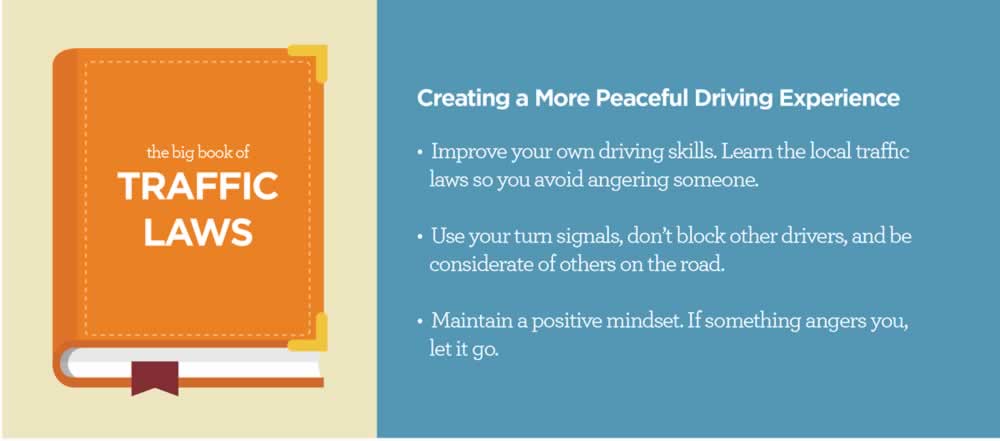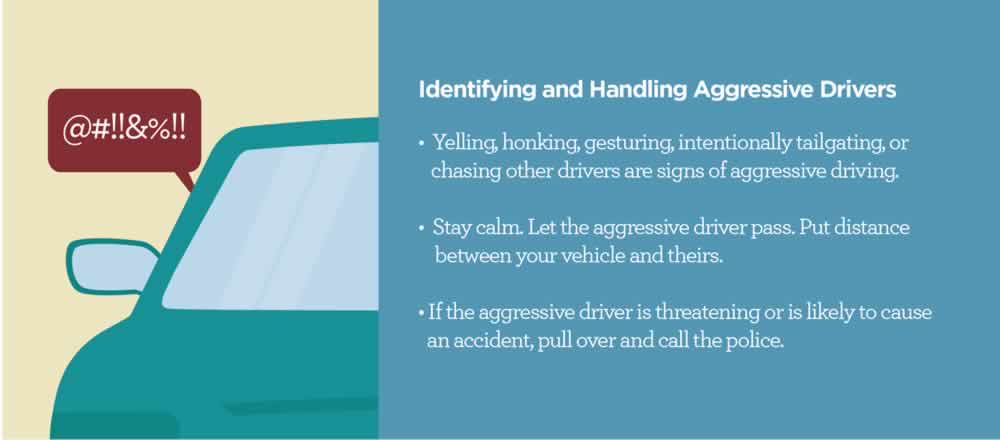Road rage. It’s a familiar feeling for anyone who’s driven a car. It’s a fear that’s re-enforced by all-too-frequent, and often frightening, headlines. Road rage instances range from annoyingly dramatic to very intense to, in scary situations, violent.
What driver hasn’t witnessed another motorist driving while distracted, dangerously tailgating, swerving through traffic at high speed, or gesturing rudely at others on the road? For that matter, what driver hasn’t felt a surge of anger after being cut off or having another car slide into the parking space they’d been patiently waiting for? What about when you are stuck in a traffic jam or behind a driver who is texting and driving?
Road rage and aggressive driving—the two terms are often used interchangeably, though both exist along a spectrum of bad behavior—are not rare events. In fact, per 2020 AAA research, “Over 80% of U.S. drivers have engaged in aggressive driving behaviors like running red lights or flipping off another driver, but these habits don’t always escalate to road rage.”
AAA also researched the likelihood of aggressive driving in the United States found the below:
26%
of U.S. drivers are likely to aggressively switch lanes while close to another car
Estimated total number of drivers: 57 million
31%
of U.S. drivers are likely to run a red light
Estimated total number of drivers: 68 million
32%
of U.S. drivers are likely to honk or make rude gestures
Estimated total number of drivers: 71 million
34%
of U.S. drivers are likely to tailgate to prevent another car from merging in front of you
Estimated total number of drivers: 74 million
48%
of U.S. drivers are likely to drive 15 mph or more over the highway speed limit
Estimated total number of drivers: 106 million
Scary, right?
Thankfully, many states have been enacting laws for hundreds of years to help make the roads a safer place, and still are to this day. Just this past June, Utah became the first state to launch a Road Rage Enhancement Law, “representing a significant stride in addressing the escalating problem of aggressive driving behaviors.“
So, what can you do to avoid angry drivers, manage your own traffic-induced frustration, and generally stay safe on the road? Here are some basics on how to identify and deal with aggressive driving.
Defining Road Rage and Identifying Aggressive Driving
The National Highway Traffic Safety Administration (NHTSA) defines aggressive driving as when “an individual commits a combination of moving traffic offenses so as to endanger other persons or property.” Road rage, according to the NHTSA, emerged as a label to “describe the angry and violent behaviors at the extreme of the aggressive driving continuum.”
Behaviors that can be classified as aggressive driving and/or road rage include:
- Yelling, honking, gesturing at other motorists
- Blocking other drivers from changing lanes
- Intentionally tailgating or cutting others off
- Chasing or challenging other drivers
- Getting out of the car to accost another person or vehicle
- Using a vehicle to purposefully ram other cars
Handling Aggressive Drivers
If another driver is behaving aggressively or erratically:
- Do whatever is appropriate, legal and safe in the circumstances to put as much distance between your vehicle and theirs as possible.
- Avoid becoming embroiled in a confrontation.
- Stay calm if they insult you or try to initiate a race or a fight.
- Let the other driver pass.
- Resist the temptation to punish someone’s bad behavior or to retaliate yourself.
- Call the police if the aggressive driver is threatening others, appears likely to cause an accident or is otherwise acting in a truly frightening manner. If the aggressive driver is just being a run-of-the-mill brat, try to ignore them and focus on something more positive instead (more tips on how to do this below!).
Ask Yourself: Are You an Aggressive Driver?
Being self-aware on the road is a hard but necessary first step to ensure your safety and the safety of everyone around you. Make an effort to observe your feelings and behaviors when you’re behind the wheel, and try speaking with family members who frequently ride with you and have the chance to watch how you act in the driver’s seat. If you or your passengers notice that you often express anger or impatience, or that you seek confrontations with other drivers, that’s a good indication that something is wrong.
Here’s the thing: Feeling outraged toward a driver behaving badly (endangering pedestrians, say) is totally normal. But frequently expressing anger—at other drivers, stop lights or the wait time at the drive-through, for example—and lashing out at or challenging other drivers is an extreme reaction and can have deadly consequences.
Managing Your Own Road Rage
If you have a tendency to drive aggressively or become enraged on the road:
- Try not to get behind the wheel when you’re likely to be provoked. Take public transportation during rush hour, let someone else drive, or simply postpone your trip when you’re in a bad mood.
- While driving, try listening to calming music or interesting audio-books.
- When you see another driver doing something aggravating, focus on breathing deeply and remind yourself that your safety is more important than getting back at some impolite (and possibly dangerous) stranger.
- Ultimately, consider getting help. Aggressive driving is extremely common (remember that 80% statistic?) and there are plenty of resources available to those who need help. Look into anger management classes or therapy, and research other steps you can take to reduce anger and stress in all areas of your life. For example, cognitive-relaxation techniques have been shown to reduce rage in “high-anger drivers.”
Creating a More Peaceful Driving Experience

It’s not your fault that some drivers act like the rules don’t apply to them. However, you can create a more enjoyable driving experience and avoid unintentionally angering an aggressive driver by improving your own driving skills (which will also help you avoid common auto claims).
Road rules and general tips that can make any drive go more smoothly are:
- Know and follow the traffic laws in the jurisdiction where you’re driving.
- Make sure to use your turn signals appropriately.
- Avoid blocking other drivers or pedestrians.
- Come to a complete stop at stop signs.
- Stay within the speed limit.
- Be aware and considerate of others on the road, always. (Including parking lots!)
- Leave yourself plenty of time to get where you’re going and always use your GPS, even if you know where you are going, to help avoid traffic and congestion. Every situation is more stressful when you’re either late, lost or both.
- Drive at less congested times and take back roads instead of busy highways, if possible. This won’t insulate you from rude or reckless drivers, but it can improve your driving experience and cut down on time you spend stuck in traffic.
Here’s the thing: You can’t control others, but you can control how you react to them. Try to maintain a positive frame of mind. If something angers you, let it go. Don’t waste time obsessing over entitled or inconsiderate motorists.
Stop the Cycle
Although aggressive driving is a common occurrence, and a serious issue, it’s not an inevitable part of every drive. It all starts with your mindset.
If you are teaching a new driver in your household the rules of the road, be sure to include tips on how to avoid road rage and what to do when they see it from other drivers to stop the cycle.
So, the next time someone tells you to “drive safely,” think “drive calmly.”
Take the Pledge
Download and print your certificate today and promise to drive distracted free, and yes, that includes keeping your emotions in check. Together we can make the roads a safer place to drive.











Safety first!
It’s a good reminder to stay calm, drive relaxed and be flexible in terms of timing and traffic.
Very informative and thought-provoking. Thank you for all the reminders on how to cope with road rage. This is a helpful add-on to the driving events measured in the TruLine app.
When driving on the freeway I see a lot of road rage. I have seen people raging at each other and trying not to let another car pass them on the right, speeding up and driving reckless. I just exited to the rest area and let them get on down the road. I’m not going to be involved in an accident they cause.
Thanks. It was a nice fresher of what could be this day and age.
Since I am a writer, I respond to aggressive driving by writing about it, mostly in response to posts from other drivers who express entitlement to travel well in excess of the speed limit. I wrote to our local police chief to alert him and his staff to watch out for such behaviors. I agree with the part of your post which says that we must learn the local laws, but for safety, and not just avoid angering other drivers, and with the further caveat that, if I have any doubt as to whether to slow down or stop, I would rather err on the side of safety, and slow down or stop. The driver behind me must maintain a slow enough speed and proper distance (one car length per 10 miles per hour of speed, and double this distance on wet roads) in order to be able to stop if I “stop short.” The driver behind has the greater duty, and the driver behind me will be legally liable if he strikes my vehicle in the rear. And the driver behind me cannot always see what is in front of me; so, I may come to a complete stop at a Yield sign, for example, if I see oncoming traffic in the traffic circle ahead. Also, I will plan my turns, and get in the left lane in advance, and stay in the left lane, putting my left turn signal on well in advance to signal that I am preparing to make a left turn up ahead, and so the driver behind me knows that I intend to make a left turn up ahead. The speed limit is just that, the upper limit that one may travel safely on a dry road, on a clear day, with clear visibility, and as traffic and other conditions allow. Also, if people travel more slowly in general, they would not have to slam on their brakes, and swerve to avoid accidents as they would have planned, and they would have allowed enough time and distance to react without being surprised, and then may not have to take extreme measures to avoid an accident.
This is an excellent article. The information is extremely helpful and the statistics are both amazing and frightening.
One technique I employ when encountering a driver exhibiting dangerous skills, is to change my thought process. When seeing someone weaving in/out/around traffic, or speeding/tailgating, my visceral reaction is, “If they wanna take their own lives in their hands unnecessarily, they can do it – BUT DON’T JEOPARDIZE MINE!” I feel righteously indignant. That’s fair + logical. But, if I start to feel vengeance welling up inside me, I’m now allowing their dangerous behavior to allow myself to respond in kind. That only causes two of us to drive recklessly + provide double the opportunity for accidents.
So, I make a concerted effort to change my mindset. While I cannot impact their thought process, I can most certainly improve my own. So, here’s what I change my thoughts to: If I were to drive as they are, I’d have to be half-crazed.
That’s a horrible feeling; I know because I’ve experienced it. I cannot change how they are feeling, but I can send some positive energy out to the Universe on their behalf. Not everyone believes in a Divine Entity; I happen to – so, very quickly I think, “Heavenly Father, please help this driver.” That’s it. Then I’m done. Very succinct + very sincere. I addressed the situation wherein I felt wronged and responded with love. Vicious cycle ended.
Very informative.
Staying the speed limit is hard as most go much faster. And pulling a travel trailer, 30 ft. is I tery to travel a little slower because of safety.
My road rage was cured when I began using random acts of kindness. I actually looked for opportunities to let them in and ignored the bad ones. It’s been working for over 15 years. I HIGHLY recommend it!
Since enrollment in the Hartford driving app I’ve become more aware of my driving behavior and experience a new level of calm and relaxation while driving. I’m enjoying it, thanks!
Very interesting and informative article. I quit driving on the highway 40 years ago because of a Road Rage incident that intimidated me. I never regretted it, but it sure has caused a lot inconvenience in my life.
too many drivers are distracted today, they get frustrated with any small inconvenience that comes their way. aggressive driving and speeding makes matters worse. I was a professional driver (CDL) for fifty years and I try to position myself on the road for maximum comfort and safety. a little courtesy goes a long way
What a timely article. A good reminder.
I liked it all. Specially “drive calmly”, instead of “drive safely”( for a two decades old sensibility behind the wheel! )
good ideas here. When I am stressed -either behind the wheel or nor – I turn on some classical music ( light variety type like adagios or movie themes).
Thank you for an eye opener
Very informative and helpful. Thanks for sharing.
Very good article. Many people here in California have entitlement issues on the road. The young teenagers should have more respect for the road as they are taught to drive. They use the car as a tool rather than a machine. Hats off to you for addressing the road rage issue.
Thanks for sharing